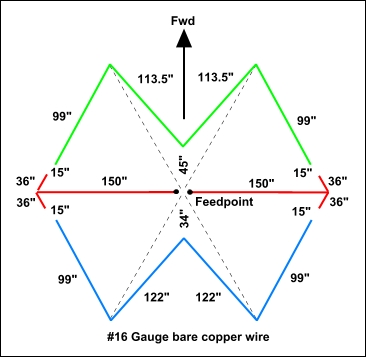3-Element Hexbeam

At the end of March 2007 I carried out some limited modelling of a 3-element 20m monoband Hexbeam with the topography show in the drawing on the right. The basic support structure remains hexagonal so I guess it's probably still OK to call it a Hexbeam. It has a radius of 150" - that's 50% bigger than a 20m 2 element design.
I claim no originality for the design, which I first spotted on the RQuad website.
Nor do I claim that these are optimum or final dimensions - they were simply the best I found in my first few hours modelling. Other sets of dimensions I tried gave better gain, better F/B, or better performance bandwidth, but always at a cost to the other parameters; the dimensions shown represent what I judge to be a reasonable performance compromise.
Note that these are the dimensions straight from the EZNEC model - they make no allowance for any "EZNEC frequency offset" which might apply. Until I get the time to build a practical model I wont know if any "correction factors" are needed.
I would expect the dimensions to scale linearly with frequency for other bands although I have not yet tried this.
So what do we get for a 50% increase in size ? This chart compares the performance of the 3 element design with a Classic 2-element Hexbeam.

Notice:
- the peak Front-to-Back performance of the 3 element antenna is significantly better;
- the 10dB F/B bandwidth of the 3 element design is marginally greater;
- the SWR of the 3 element antenna is below 2:1 across the useful F/B bandwidth; but note that this is referenced to 12.5 Ohms. The feedpoint impedance of the 3 element antenna is lower than the 2 element design at about 12 Ohms. This makes it easy to match, either with a 4:1 balun or, perhaps, by "folding" the driven element;
- the Forward Gain is relatively flat across the band, unlike that of the 2 element beam which falls significantly as the frequency increases. At 14.100 MHz the 3 element advantage is 2 dB, rising to 3.5dB by 14.260 MHz.
There are no surprises here. We would expect the addition of the extra element to imrove the directivity. However, the "W" shape of the Director and Reflector makes these parasitic elements relatively narrowband, limiting the performance bandwidth to something very similar to the 2 element Hexbeam.
I'll leave you to judge whether the performance improvement is worth the 50% increase in size!

Finally you may be interested to see the performance of the 3 element Hexbeam compared with a trapless, short-boom, 3 element Yagi. This Yagi has a boom length of 16ft, its longest element is 35.5ft, and it has a turning radius of 19.25ft (231").
The Yagi F/B performance is clearly superior; it never falls below 23dB over the whole band, and it peaks at 45dB. However it's Forward Gain is no better than the Hexbeam - indeed for much of the band it is 0.2 - 0.6dB worse.
This is quite remarkable, given that the Hexbeam turning radius is 65% that of the Yagi (150" vs 231"). I can think of few other trapless/unloaded antennas that will deliver this sort of Forward Gain with such a small turning radius; and remember the other advantages of the Hexbeam approach: lightweight, low cost, and easy to add extra bands. Increasing the boom length of the Yagi to 22.5ft would deliver a further 1dB of Forward Gain, but it damages the F/B performance and increases the turning radius to 20.6ft (248").
So, if Forward Gain is your primary concern, maybe the 3 element Hexbeam is the way to go!